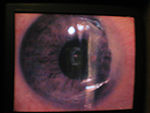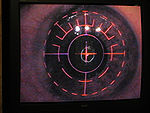LASIK eye surgery
LASIK eye surgery (Laser-Assisted In Situ Keratomileusis) is a surgical vision correction procedure that uses a laser to create a thin flap on the cornea and then reshape the cornea. It has the abilities to correct one's vision to a perfect 20/20 and has allowed many people to attain personal or vocational goals previously thought unreachable: attaining the position of a military fighter pilot or a career in the professional sports arena. LASIK was approved by the U.S. Food and Drug Administration in 1995 and since then has grown to a point where over one million Americans received the procedure in 2009. LASIK's growth peaked in 2007, but dropped off due to the ensuing economical crisis [1][2].
Surgical Procedure
Preparation
The first step one should take when considering LASIK surgery is to meet with an experienced, reputable LASIK eye surgeon [3]. Factors to consider when picking an eye surgeon include: credentials and licensing, board certification, experience, membership in the American College of Surgeons, rates of complication, and how complications are dealt with. Also, do not hesitate to visit the surgical location beforehand and get a feel for the staff and doctors.[4]
A candidate for LASIK eye surgery must be examined and given the go ahead by an eye doctor. The doctor will be looking for eye diseases or any condition that might keep the eye from properly healing, i.e. chronic dry eyes. Certain diseases which affect eye sight, such as cataracts and glaucoma, can prevent one from consideration. General requirements for LASIK include: being of legal age (18 and in some states 21), not being pregnant, not having an autoimmune disease, as those can interfere with the healing process, acceptable use of certain medications, and having had stable vision for at least a year. Teenagers and young adults often have ever-changing prescriptions which thus disqualifies most young people from LASIK [5]
During a pre-op visit, a map of the patient's cornea is created by using a corneal topographer. The topographer determines the curvature of one's eye in a very easy, painless procedure- a picture is flashed in front of the lined-up eye and the computer then prints out a colored map. Different colors reflect the different grades of steepness in the cornea [6]
Once a surgeon is chosen, the patient passes the eye examination, and the date of surgery is picked, there are several things one can do to prepare oneself and one's eyes for the procedure. Because corrective contact lenses slightly change the shape of one's cornea, do not wear hard contacts for four weeks prior to surgery, gas permeable contacts for three weeks, and soft contact lenses for two weeks. The day before the surgery refrain from the use of lotions, makeup, creams, and anything else that may cause debris to enter into the eye. On the day of the surgery, again, refrain from the use of make up and anything that would allow debris into the eye and increase the chance of eye infection. If you are feeling quite sick before your appointment make sure to call and talk to your surgeon to determine whether the surgery should go on as scheduled [7]
Process
The surgical process of LASIK is very short, usually taking only five minutes. The severity of the vision problems ultimately determine the length of the procedure; for those with worse eyes, the procedure takes longer than those with comparably better eyesight [3]. Before the procedure the doctor will once again examine and measure the eye. They will also give the patient a chance to ask any questions or express additional concerns. For overly worried or anxious patients, medication or local anesthesia may be used. [7] Numbing drops are applied to the eye to lessen the chance of discomfort or pain from pressure.
The patient then lies down and the eye is lined up directly under the laser. A speculum (a retainer like device) is used to keep the eyelids open. Only one eye is operated on at a time, and the other eye is covered by a protective shield[3].
The first step of the surgery is the creating of the corneal flap. The corneal flap serves as a protective layer which will aid in and allow the cornea to heal. The surgeon will use either a microkeratome, femtosecond, or intralase laser to create this flap depending on the patient's cornea and treatment plan. [7] The flap created is very thin and not visible to the patient. The flap is securely fastened to the cornea, and acts somewhat as a hinge. During this corneal flap procedure the patient is asked to look at a blinking light. The next step of the surgery is the actual reshaping of the cornea with an excimer laser. As the patient continues looking at the blinking target light the surgeon uses a computer and the laser to remove the exact amount of corneal tissue in order to fix the patient's refractive error. The computer adjusts the laser depending on the patient's particular prescription and then sudden bursts are sent from the laser to the cornea. Keep in mind that the surgeon is the one in charge of the laser and the procedure can be paused or stopped at any necessary time. The laser makes a constant clicking noise and some report to detecting a mild odor during the procedure. If a patient is having both eyes operated on during the same appointment the second eye is generally started right after the first eye, with little to no time in between [3].
Recovery
After the operation, one cannot drive, so arrangements need to be made prior to the appointment day. After going home, it is recommended to rest for at least two hours, if not the whole day. It is okay to go back to work the next day, but one is encouraged to wait a few days before returning. Rubbing of the eye is highly discouraged, as well as vigorous exercise for the next week. Pain or discomfort is fairly rare after this surgery, but the doctor may prescribe pain medication. The most important thing is that one chooses to listen to and obey their eye surgeon's instructions [3].
Usually a patient's improvement is immediate, but sometimes is more gradual. A regression of eye sight or the notice of a complication is grounds for immediately speaking with your LASIK eye surgeon or, perhaps, a second surgeon if you feel the procedure was not done correctly [3].
Benefits
LASIK provides the opportunity for improved vision without the use of glasses or contact lenses. Without the need for corrective eye wear one can easily engage in a multitude of activities which they once could not: biking, swimming, diving, and sports in general. It can also open up different career field options; pilots and some positions in law enforcement require near perfect vision without the use of corrective lenses. Lastly, LASIK can also increase one's self confidence, allowing them not to squint, ask for directions, or fumble around [8].
Although results are not always immediate, the vast majority report a significant change in their vision, and only 3% report a worsening of vision after surgery. LASIK holds the highest rating of satisfaction of any other elected surgery; after surgery 95% of patients said they were pleased with their results. One's chances of having perfect 20/20 vision after surgery are at 85% and the chances of having 20/40 vision or better afterwards are 92%. LASIK surgery has become very popular in the military. Between 2000 and 2008, 224,000 military personnel had the procedure performed. A study was also conducted with U.S. Navy and Marine Corps aviators who had recently undergone wave-front guided LASIK. All patients gained vision of 20/20 or better within the first two weeks. Within one month, 95% thought that the procedure improved their ability to do their job as a pilot and 100% would recommend the procedure to a friend [9].
Risks and Complications
During the 1990's as LASIK was first being introduced, the rate of complications was measured at 5%. Since then, the development of technology and the increased knowledge in the field has allowed the number of serious complications to lower to less than 1%. The FDA reported minor LASIK complications to be somewhere between 1% and 5% [9]. Although the chances of a serious complication occurring are very small, it still does happen. The best way to safeguard against vision problems is to pick the right surgeon. Picking an experienced, reputable surgeon will greatly decrease the chances of having serious complications. [10]
Common eye problems after LASIK surgery include:
- Eye infection
- Dry eyes
- Double vision
- Halos around sources of light, affecting 3.5% of patients
- Sensitivity to light, affecting 1.7% of patients
- Visual changes, affecting 2.6% of patients
- Keratectasia
- Diffuse Lamellar Keratitis
References
- ↑ Laser Eye Surgery Industry Growth and the Economy
- ↑ Patients are Blindsided By Dangers of LASIK Surgery: Thousands Suffer Lasting Eye Damage after Procedure By Susan Ferraro
- ↑ 3.0 3.1 3.2 3.3 3.4 3.5 The LASIK Procedure: A Complete Guide By Liz Segre; reviewed by Charles Slonim, MD, and Brian S. Boxer Wachler, MD. All About Vision
- ↑ How To Choose a LASIK Surgeon By Liz Segre, with updates by Marilyn Haddrill; reviewed by Robert L. Epstein, MD. All About Vision.
- ↑ LASIK Criteria for Success By Liz Segre; guidelines supplied by Charles Slonim, MD, and Brian S. Boxer Wachler, MD. All About Vision.
- ↑ Corneal Topography Indiana University School of Optometry.
- ↑ 7.0 7.1 7.2 Preparing for LASIK Vision Correction DocShop.com.
- ↑ LASIK eye surgery benefits DocShop.com
- ↑ 9.0 9.1 LASIK Surgery Statistics Doc.Shop.com
- ↑ Laser Risks and Complications By Marilyn Haddrill, with updates by Gary Heiting, OD; reviewed by Brian S. Boxer Wachler, MD. All About Vision
| ||||||||||||||||||||




